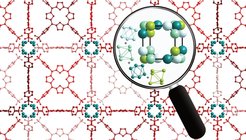Resolving the Zr8O6 cluster conundrum in PCN-221
Disorder and linker deficiency in porphyrinic zirconium-based metal–organic frameworks
Novel materials form the basis of new technologies and processes and are a key driver for innovation. Metal–organic frameworks (MOFs) provide a mix-and-match platform for the combination of metal atoms or clusters linked by organic molecules into three-dimensional networks with customizable pore shapes, sizes, and functionality towards a wide range of applications including gas storage and separation, catalysis, sensing, and biomedical applications.
One family of MOFs, uniting zirconium-oxo-clusters with special pigment-related molecules called porphyrins, currently garners significant attention for their high stability and interesting (opto)electronic properties, including the archetypical MOF PCN-221. The variety of cluster species and an intrinsic propensity for the organic molecules to interact with additional metal species imbues further attractive functionality compared to other MOFs, but also results in complicated and defect-prone structures that are difficult to characterize. While clusters with six zirconium atoms (Zr6O4(OH)4) are the most common, cubic shaped clusters reported for PCN-221 based on eight zirconium atoms (Zr8O6) have remained controversial ever since the discovery of this MOF family. This cluster conundrum has a significant impact on how we can utilize, interpret and tune the properties innate to Zr-based MOFs.

As published in Nature Communications 12, 3099 (2021) – Open Access, a team at the Max Planck Institute for Solid State Research, the University of Bayreuth, LMU Munich, and DESY has finally resolved this long-standing question about the existence of cubic Zr-oxo clusters in PCN-221. By using a combination of state-of-the-art analytical techniques which are sensitive to different (local and long-range) length scales, the researchers showed that contrary to common knowledge, the Zr8O6-cluster in PCN-221 is in fact a superposition of four Zr6O4(OH)4 clusters with different orientations within the network. This superposition has previously been interpreted as a cubic motif, explaining the original identification as Zr8O6 cubes (see Fig. 1). Further investigations of the defect-prone structure revealed that a large proportion of the organic linkers was also missing, drawing analogy to another family member: PCN-224, a MOF with the same Zr6O4(OH)4 clusters but ordered vacancies. The newly established structural model for PCN-221 was, therefore, dubbed disordered PCN-224 (dPCN‑224), and allows for an improved understanding of the entire family of porphyrin-based MOFs in terms of varying degrees of orientational cluster disorder, linker vacancies, and cluster-linker binding modes.
This work sheds light on the intricate interplay between network topology, defects, and disorder in Zr-MOFs, and opens up a unique design space by invoking additional degrees of freedom such as correlated cluster orientation, cluster disorder, and cluster–linker binding modes. Once controlled, these design criteria will unleash a huge untapped potential for directing the functional properties of MOFs in areas where defect chemistry is fundamental, like in (photo)catalysis, gas separation, and drug delivery.











